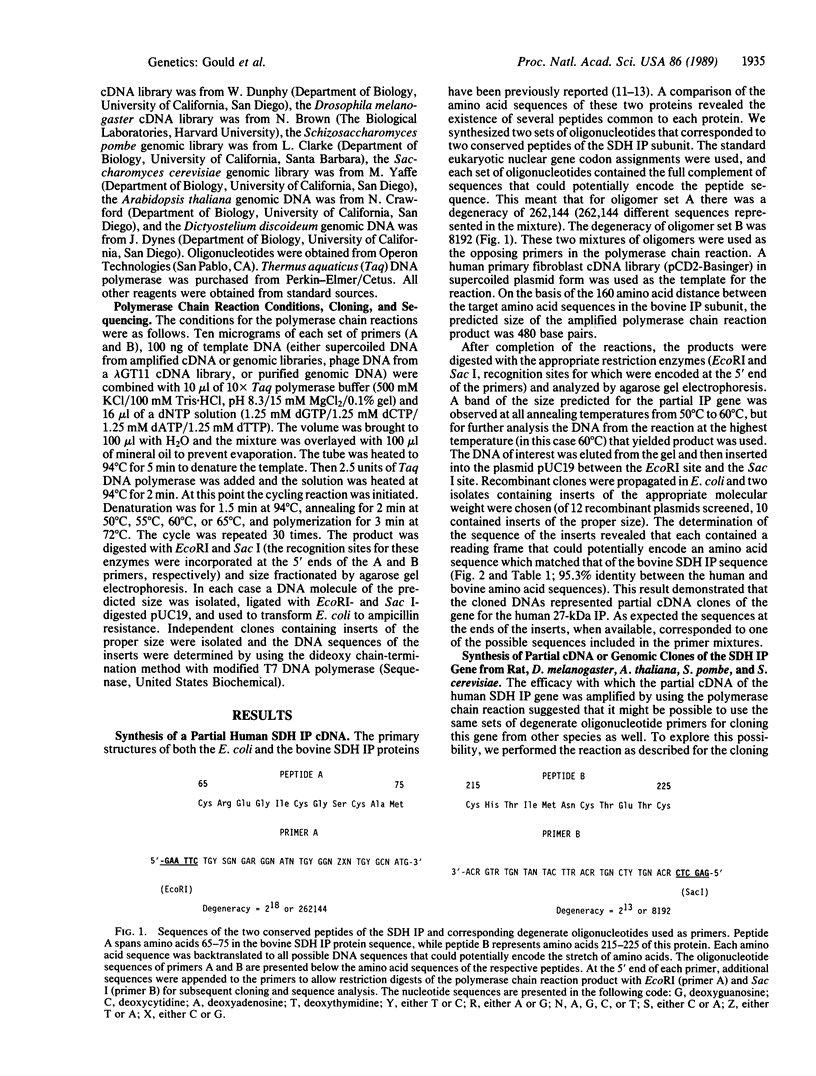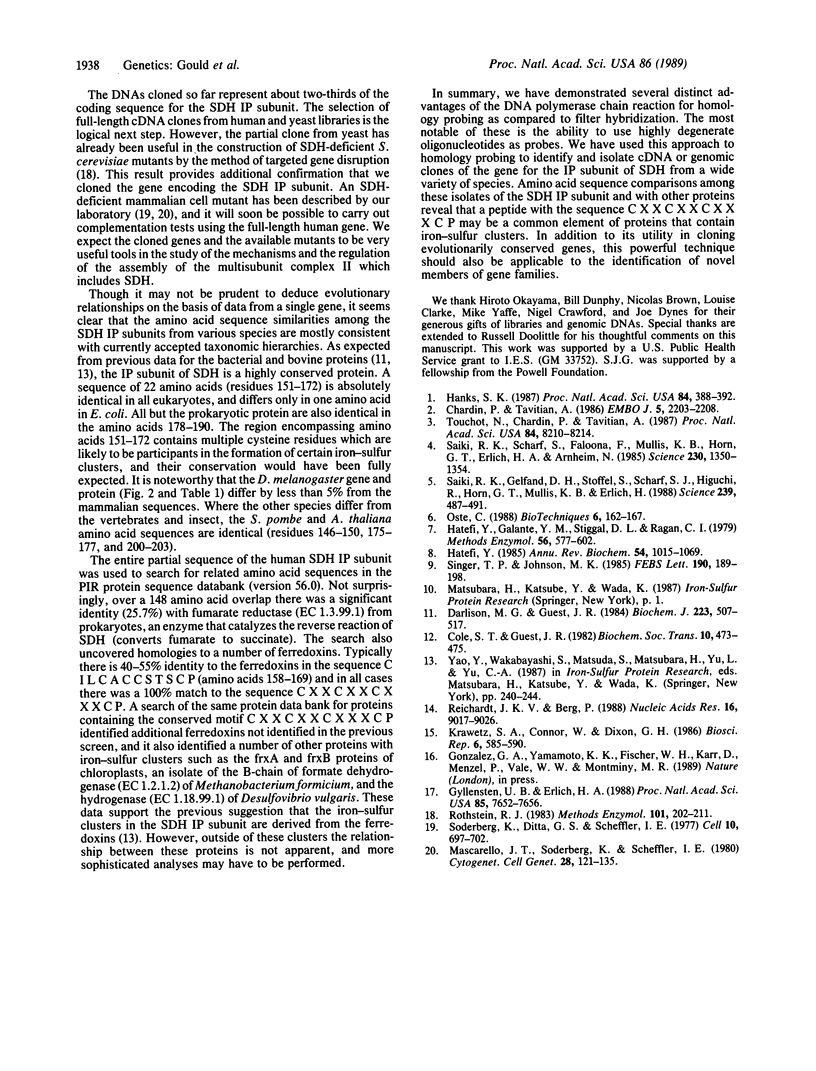Abstract
The DNA polymerase chain reaction was developed for in vitro amplification of specific DNA sequences, and it has been used for a wide variety of purposes in several fields. We have developed an application of the polymerase chain reaction that is useful for the isolation of partial cDNA or genomic clones of conserved genes. We used this technique to clone the gene encoding the iron protein subunit (27 kDa) of succinate dehydrogenase (EC 1.3.5.1) from several species, including human, rat, Drosophila melanogaster, Arabidopsis thaliana, Schizosaccharomyces pombe, and Saccharomyces cerevisiae. Mixed oligonucleotide primers corresponding to two conserved regions of the protein were used in conjunction with genomic and cDNA templates in the reaction. The primers contained all possible nucleotide combinations that could encode the corresponding peptide sequences. These oligonucleotide mixtures contained 262,144 (2(18] and 8192 (2(13] unique sequences, respectively. Use of the polymerase chain reaction for homology probing allows one to utilize more complex mixtures of oligonucleotides as probes than is possible with filter hybridization screening techniques. In addition, the polymerase chain reaction offers the advantage of synthesizing the DNA product directly, in some cases obviating the need to construct cDNA or genomic libraries. This application of the polymerase chain reaction should be useful not only for the identification of conserved genes in a variety of species but also for the isolation of previously unknown members of gene families.
Full text
PDF




Selected References
These references are in PubMed. This may not be the complete list of references from this article.
- Chardin P., Tavitian A. The ral gene: a new ras related gene isolated by the use of a synthetic probe. EMBO J. 1986 Sep;5(9):2203–2208. doi: 10.1002/j.1460-2075.1986.tb04485.x. [DOI] [PMC free article] [PubMed] [Google Scholar]
- Cole S. T., Guest J. R. Molecular genetic aspects of the succinate: fumarate oxidoreductases of Escherichia coli. Biochem Soc Trans. 1982 Dec;10(6):473–475. doi: 10.1042/bst0100473. [DOI] [PubMed] [Google Scholar]
- Darlison M. G., Guest J. R. Nucleotide sequence encoding the iron-sulphur protein subunit of the succinate dehydrogenase of Escherichia coli. Biochem J. 1984 Oct 15;223(2):507–517. doi: 10.1042/bj2230507. [DOI] [PMC free article] [PubMed] [Google Scholar]
- Gyllensten U. B., Erlich H. A. Generation of single-stranded DNA by the polymerase chain reaction and its application to direct sequencing of the HLA-DQA locus. Proc Natl Acad Sci U S A. 1988 Oct;85(20):7652–7656. doi: 10.1073/pnas.85.20.7652. [DOI] [PMC free article] [PubMed] [Google Scholar]
- Hanks S. K. Homology probing: identification of cDNA clones encoding members of the protein-serine kinase family. Proc Natl Acad Sci U S A. 1987 Jan;84(2):388–392. doi: 10.1073/pnas.84.2.388. [DOI] [PMC free article] [PubMed] [Google Scholar]
- Hatefi Y., Galante Y. M., Stiggall D. L., Ragan C. I. Proteins, polypeptides, prosthetic groups, and enzymic properties of complexes I, II, III, IV, and V of the mitochondrial oxidative phosphorylation system. Methods Enzymol. 1979;56:577–602. doi: 10.1016/0076-6879(79)56056-x. [DOI] [PubMed] [Google Scholar]
- Hatefi Y. The mitochondrial electron transport and oxidative phosphorylation system. Annu Rev Biochem. 1985;54:1015–1069. doi: 10.1146/annurev.bi.54.070185.005055. [DOI] [PubMed] [Google Scholar]
- Krawetz S. A., Connor W., Dixon G. H. Oligonucleotides as probes for mammalian protamine mRNAs. Biosci Rep. 1986 Jun;6(6):585–590. doi: 10.1007/BF01114956. [DOI] [PubMed] [Google Scholar]
- Mascarello J. T., Soderberg K., Scheffler I. E. Assignment of a gene for succinate dehydrogenase to human chromosome 1 by somatic cell hybridization. Cytogenet Cell Genet. 1980;28(1-2):121–135. doi: 10.1159/000131520. [DOI] [PubMed] [Google Scholar]
- Oste C. Polymerase chain reaction. Biotechniques. 1988 Feb;6(2):162–167. [PubMed] [Google Scholar]
- Reichardt J. K., Berg P. Conservation of short patches of amino acid sequence amongst proteins with a common function but evolutionarily distinct origins: implications for cloning genes and for structure-function analysis. Nucleic Acids Res. 1988 Sep 26;16(18):9017–9026. doi: 10.1093/nar/16.18.9017. [DOI] [PMC free article] [PubMed] [Google Scholar]
- Rothstein R. J. One-step gene disruption in yeast. Methods Enzymol. 1983;101:202–211. doi: 10.1016/0076-6879(83)01015-0. [DOI] [PubMed] [Google Scholar]
- Saiki R. K., Gelfand D. H., Stoffel S., Scharf S. J., Higuchi R., Horn G. T., Mullis K. B., Erlich H. A. Primer-directed enzymatic amplification of DNA with a thermostable DNA polymerase. Science. 1988 Jan 29;239(4839):487–491. doi: 10.1126/science.2448875. [DOI] [PubMed] [Google Scholar]
- Saiki R. K., Scharf S., Faloona F., Mullis K. B., Horn G. T., Erlich H. A., Arnheim N. Enzymatic amplification of beta-globin genomic sequences and restriction site analysis for diagnosis of sickle cell anemia. Science. 1985 Dec 20;230(4732):1350–1354. doi: 10.1126/science.2999980. [DOI] [PubMed] [Google Scholar]
- Singer T. P., Johnson M. K. The prosthetic groups of succinate dehydrogenase: 30 years from discovery to identification. FEBS Lett. 1985 Oct 14;190(2):189–198. doi: 10.1016/0014-5793(85)81282-5. [DOI] [PubMed] [Google Scholar]
- Soderberg K. L., Ditta G. S., Scheffler I. E. Mammalian cells with defective mitochondrial functions: a Chinese hamster mutant cell line lacking succinate dehydrogenase activity. Cell. 1977 Apr;10(4):697–702. doi: 10.1016/0092-8674(77)90103-9. [DOI] [PubMed] [Google Scholar]
- Touchot N., Chardin P., Tavitian A. Four additional members of the ras gene superfamily isolated by an oligonucleotide strategy: molecular cloning of YPT-related cDNAs from a rat brain library. Proc Natl Acad Sci U S A. 1987 Dec;84(23):8210–8214. doi: 10.1073/pnas.84.23.8210. [DOI] [PMC free article] [PubMed] [Google Scholar]


